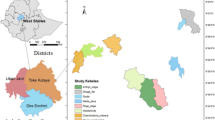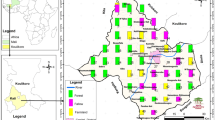Abstract
Woody vegetation in cultivated landscapes in Burkina Faso is influenced by agricultural activities that are in turn influenced by institutional arrangements. Research was undertaken in a village in south-west Burkina Faso to investigate the relationship between species composition, diversity, density, species accumulation and land use category. Additionally the relationship between number of trees, size of farmed land and farmer ethnicity was investigated. Indigenous Tiéfo farmers had on average more than double the number of large (>4 m) trees of Vitellaria paradoxa Gaertn. f., Parkia biglobosa (Jacq.) R. Br. Ex G. Don and Anacardium occidentale L. than farmers belonging to other ethnic groups, but this was partly explained by a larger area being available. Differences between ethnic groups were not significant when expressed per ha. Botanical inventories of fallows more than 4 years old, cultivated parklands and plantations of Mangifera indica L. and A. occidentale showed that tree density and Simpson’s index of diversity for trees were highest in the fallow. Simpson’s index was not significantly different for regeneration, but sample-based species accumulation curves indicated that species accumulation in parklands was faster than in plantations when expressed per individual. The average regeneration density was 12,605, 1,995 and 6,772 seedlings ha-1 for fallow, parklands and plantations, respectively. This low density for parklands means that species accumulation is slow compared to the other land uses when expressed per unit area. Fallow seems the most efficient way of keeping tree diversity in the agricultural landscape.

Similar content being viewed by others
References
Arbonnier M (2002) Arbres, arbustes et lianes des zones sèches d’Afrique de l’Ouest, 2nd edn. CIRAD, France, 573 pp
Augusseau X, Nikiema P, Torquebiau E (2006) Tree biodiversity, land dynamics and farmers’ strategies on the agricultural frontier of southwestern Burkina Faso. Biodiv Conserv 15:613–630
Berry S (1987) Property rights and rural resource management: the case of tree crops in West Africa. African Studies Center Working Paper no. 122
Boffa J-M (1999) Agroforestry Parklands in Sub-Saharan Africa. 1999. FAO Conservation Guide, vol 34, 230 pp
Colwell RK (2005) EstimateS: statistical estimation of species richness and shared species from samples. Version 7.5. Users guide and application published at: http://purl.oclc.org/estimates
Colwell RK, Mao CX, Chang J (2004) Interpolating, extrapolating, and comparing incidence-based species accumulation curves. Ecology 85:2717–2727
Crowley PH (1992) Resampling methods for computation-intensive data analysis in ecology and evolution. Annu Rev Ecol Syst 23:405–447
Degrande A, Schreckenberg K, Mbosso C, Anegbeh P, Okafor V, Kanmegne J (2006) Farmers’ fruit tree-growing strategies in the humid forest zone of Cameroon and Nigeria. Agrofor Syst 67: 159–175
De Wolf J (1998) Species composition and structure of the woody vegetation of the middle Casamance region (Senegal). For Ecol Manage 111:249–264
Fontès J, Diallo A, Campaoré JA (1994) Carte de la végétation naturelle de l’occupation du sol Burkina Faso. ICIV, France
Gausset Q (2005) “Le foncier et les arbres dans le sud-ouest du Burkina Faso. Présentation de l’approche contractuelle de PETREA”. Serein-occasional Paper 18:37–59
Gausset Q, Ræbild A, Ky J-M, Belem B, Lund S, Yago EL, Dartell J (2003) Opportunities and constraints of traditional and new agroforestry in south-western Burkina Faso”. Paideusis. J Interdis Cross-Cultural Stud 3:1–26
Gijsbers HJM, Kessler JJ, Knevel MK (1994) Dynamics and natural regeneration of woody species in farmed parklands in the Sahel region (Province of Passore, Burkina Faso). For Ecol Manage 64:1–12
Gotelli NJ, Colwell RK (2001) Quantifying biodiversity: procedures and pitfalls in the measurement and comparison of species richness. Ecol Lett 4:379–391
Gotelli NJ, Ellison AM (2004) A primer of ecological statistics. Sinauer Associates, Sunderland, USA, 510 pp
Johnson OEG (1972) Economic analysis, the legal framework and land tenure systems. J Law Econ 15:259–276
Krebs CJ (1985) Ecology – the experimental analysis of distribution and abundance. Harper & Row Publishers, New York, 800 pp
Lovett PN, Haq N (2000) Evidence for anthropic selection of the Sheanut tree (Vitellaria paradoxa). Agrofor Syst 48:273–288
Lund C (2000) African land tenure: questioning basic assumptions. IIED Drylands Issue paper 100, 25 pp
Mertz O, Reenberg A (1999) Building on diversity: pathways to agricultural intensification in Burkina Faso. Danish J Geogr, Special issue 2:125–137
Nikiema A (2005) Agroforestry Parkland Species Diversity: Uses and management in semi-arid West Africa (Burkina Faso). Ph.D thesis, Wageningen University, Wageningen, 102 pp
Ouedraogo M (2002) Land tenure and rural development in Burkina Faso: issues and strategies. IIED Drylands Issue Paper 112, 24 pp
Paré L (2001) Negotiating rights: access to land in the cotton zone, Burkina Faso. Land Tenure and Resource Access in West Africa. IIED, London, 28 pp
Pigeonnière AL, Jomni S (eds) (1998) Atlas du Burkina Faso. Les Editions Jeune Afrique, Paris, 62 pp
Schreckenberg K (1999) Products of a managed landscape: non-timber forest products in the parklands of the Bassila region, Benin. Global Ecol Biogeogr 8:279–289
Serpantié G (1996) Rôles des jachères dans la production arborée non ligneuse en savane soudanienne. Cas du karité dans l’Ouest du Burkina Faso. In Floret C (ed) La jachère, Lieu de Production. Proceedings from the conference in Bobo-Diuolasso 2–4 octobre 1996 on Amélioration et gestion de la jachère en Afrique de l’Ouest Projet 7 ACP RPR 269. CORAF Union Européenne
Tian G, Kang BT, Kolawole GO, Idinoba P, Salako FK (2005) Long-term effects of fallow systems and lengths on crop production and soil fertility maintenance in West Africa. Nutr Cycl Agroecosyst 71:139–150
Timmer LA, Kessler JJ, Slingerland M (1996) Pruning of néré trees (Parkia biglobosa) on the farmlands of Burkina Faso, West Africa. Agrofor Syst 33:87–98
Acknowledgements
We wish to thank the inhabitants of Peni district for their hospitality and for allowing us to work in their fields. D. Ouattara, O. Ouattara and S. Ouattara assisted during the fieldwork. E.D. Kjaer provided useful comments on statistics. We thank an anonymous referee, and Q. Gausset and A.M. Lykke for comments on earlier versions of the manuscript. The research was carried out in the context of the Petrea-programme (People, Trees and Agriculture in Africa), supported by RUF (Rådet for Ulandsforskning), project no. 91042.
Author information
Authors and Affiliations
Corresponding author
Rights and permissions
About this article
Cite this article
Ræbild, A., Hansen, H.H., Dartell, J. et al. Ethnicity, land use and woody vegetation: a case study from south-western Burkina Faso. Agroforest Syst 70, 157–167 (2007). https://doi.org/10.1007/s10457-007-9043-z
Received:
Accepted:
Published:
Issue Date:
DOI: https://doi.org/10.1007/s10457-007-9043-z




